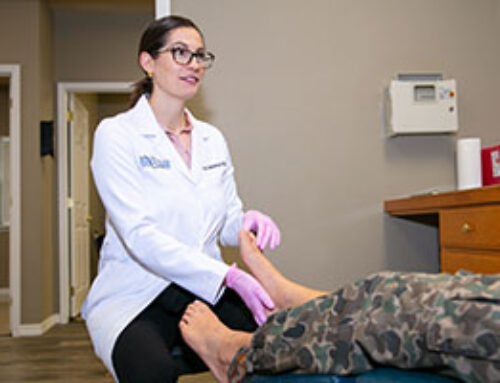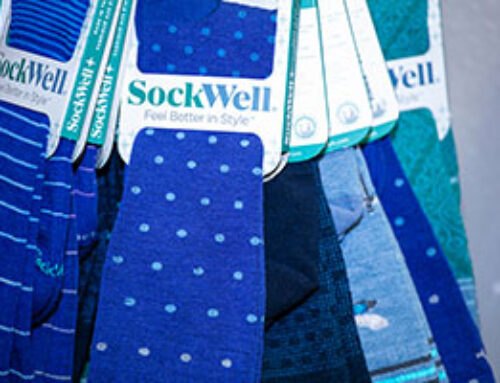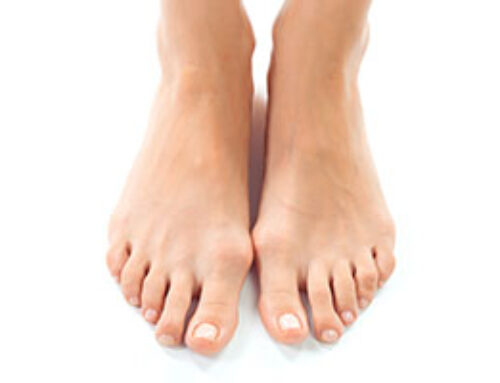If you are suffering from bunions, no one will need to tell you how painful they can be, but you are not alone. It is estimated that 88% of women wear ill-fitting shoes, and 55% of that 88% will develop bunions.
Most adults are on their feet a lot, and it is estimated that adults take between four thousand and six thousand steps per day. By the time adults reach 50, they have walked an equivalent of 75,000 miles. That is a lot of wear and tear on the feet. It is no wonder that feet problems are common issues.
What is a bunion?
A bunion, or Hallux Valgus, is a common foot deformity that causes a bony bump to form on the joint where your big toe meets your foot, known as the metatarsophalangeal (MTP) joint. When pressure is placed on this joint, this deformity is created.
A bunion is a progressive disorder and happens slowly, over time. Eventually, it becomes big enough to stick out and can cause your big toe to turn in. When bunions get bad enough, the big toe can be pushed on top of the toe onto the side of it. Many people suffer from the pain of bunions for years before seeking treatment.
What causes a bunion to be formed?
There are many things that can lead to bunions, such as rheumatoid arthritis that causes your joints to swell and hurt. Shoes that do not fit properly can all cramp your toes. Or you may simply have bunions because of the way that your feet are shaped.
What are the symptoms of a bunion?
The most obvious sign of a bunion is a bulging lump on the joint. This lump might hurt and be swollen or red and can make it hard to move on your toes, especially your big toe. When walking, you may notice a burning sensation of possible numbness in the affected area.
At what age do bunions typically appear?
Though uncommon, bunions can form in individuals as young as ten and more often found in girls as opposed to boys. No one knows why girls are more likely to have bunions than boys, but research shows that it could potentially be due to changes in footwear around that age or even just genetics. Unlike when adults get bunions, adolescents who have bunions are able to move their big toe, but it still hurts.
How are bunions diagnosed?
Bunions are generally easy to diagnose. Generally speaking, a doctor can tell you have a bunion just by looking at your foot, but they will most likely want to do an x-ray to see if the joint is damaged. In reviewing the x-ray, we are able to know how serious your bunion is and possibly what caused it. This knowledge allows our professionals to know how to treat it.
How are bunions treated?
Sometimes treating a bunion can be as simple as changing shoes, special padding for bunions, and icing your foot to manage bunion pain until you are able to have a bunionectomy to repair. Often, these treatments will buy you time, but in the end, your podiatrist may suggest a bunionectomy. Please keep in mind that a bunionectomy is not generally indicated for adolescent patients as their foot is still growing.
What is a bunionectomy and, what should I expect before having it?
A bunionectomy is a surgery to remove a diagnosed bunion. Fortunately for you, bunion surgery is a minimally invasive foot procedure and offers a quick recovery. Bunionectomies are extremely popular for their lack of cast following surgery and the ability to return to normal activities in as little as eight weeks. However, it is still a surgery and will require a bit of preparation.
The surgery works to not only remove the bunion but also to straighten your big toe. Our specialists will make a small incision and remove small pieces of bone, then setting it in a new position. Your toe may be held in place with pins, screws, wires, or staples. These may stay in your foot or be removed after a few weeks. How soon you can plan to put weight on your toe depends on how complex of a surgery you are having.
How do you prepare for surgery?
- Surgery can be incredibly stressful. As you prepare to have surgery, make sure you have someone to take you home. Rather your bunionectomy involves mild-sedation or anesthesia; it is unsafe for you to drive or get home on your own.
- If you take aspirin or other forms of blood thinners, ask your doctor if you should stop taking these before your surgery.
- Stock up on groceries prior to your procedure as you will not be able to drive to the store for a period of time.
- Our specialists will prescribe medicine to help reduce pain in the days following surgery. It is crucial that you pick up this medication in advance so that you have it when you need it.
- Make sure that all items you need and use every day are in easy to reach places. It is best to avoid going up and down stairs throughout the day, so make sure that you have items that you need on a lower level and easier to access.
- Invest in some well-fitted shoes that have plenty of arch support and a wide toe-box.
- Make sure that our number is plugged into your contacts so that you can reach our specialists for whatever you need.
What should I expect on the day of surgery?
A Bunionectomy is an outpatient procedure, which means that you will go in for the operation and come out the same day. By the time you leave, your anesthesia or mild sedation will have worn off, but you will need to have transportation arranged in advance. Mild discomfort can be expected. We also suggest having someone in your home to help care for you following your procedure, as it may be difficult to walk in the days following surgery.
What should you expect after a bunionectomy?
After your bunionectomy, you can expect for it to take six weeks or longer for swelling to go down and for it to be healed enough to resume normal activities. You may find that you have swelling or pain for as long as six months to a year.
Recovery time for bunion surgery can vary, but if you follow your doctors’ orders, you will be healed in no time at all. Like with all surgery, there is a risk, but it will leave you living pain-free, thus improving your quality of life.
As with any condition, the specialists at Metro Tulsa Foot and Ankle always seek to find the right treatment option for you. From then we will work with you to explain the surgical technique and recovery process so we can help reduce the pain and deformity that the bunion has caused.
If you suspect you have a bunion—or if you have any other concerns about the health and well-being of your feet, ankles, or lower legs—schedule an appointment today at one of our five convenient locations.
Subscribe to stay up-to-date on news and tips from us.




